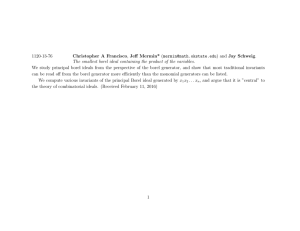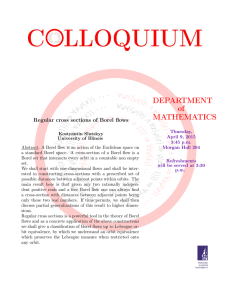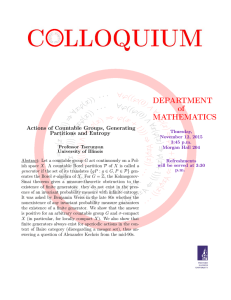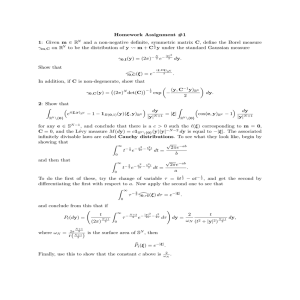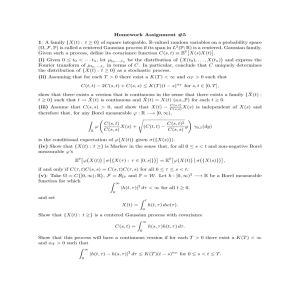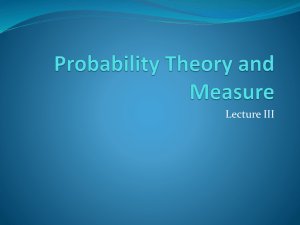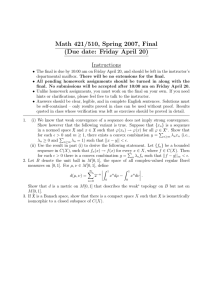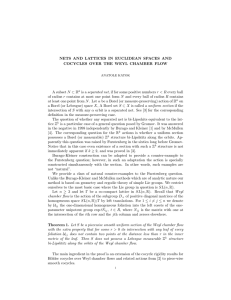Some numerical results on decompositions of Betti diagrams
advertisement
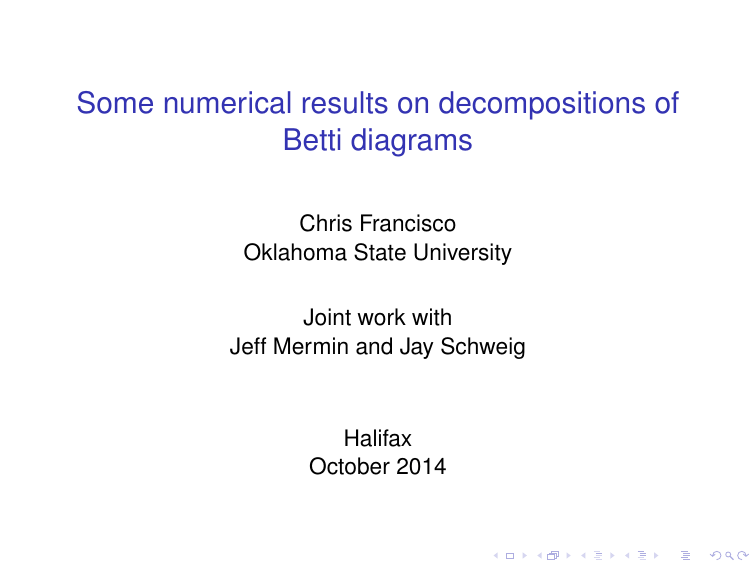
Some numerical results on decompositions of Betti diagrams Chris Francisco Oklahoma State University Joint work with Jeff Mermin and Jay Schweig Halifax October 2014 Borel ideals Let S = k [x1 , . . . , xn ], k a field. Borel ideals Let S = k [x1 , . . . , xn ], k a field. Definition: A monomial ideal M ⊂ S is a Borel ideal if • given any monomial m ∈ M, • a variable xj dividing m, and • an index i < j, Borel ideals Let S = k [x1 , . . . , xn ], k a field. Definition: A monomial ideal M ⊂ S is a Borel ideal if • given any monomial m ∈ M, • a variable xj dividing m, and • an index i < j, then m · xi ∈ M. xj Also known as strongly stable or 0-Borel ideals. Example: (a3 , a2 b, a2 c, ab2 , b3 ) is Borel. (Borel generated by a2 c and b3 .) Eliahou-Kervaire resolution of Borel ideals The Eliahou-Kervaire resolution provides a minimal free resolution of any Borel ideal B. Eliahou-Kervaire resolution of Borel ideals The Eliahou-Kervaire resolution provides a minimal free resolution of any Borel ideal B. Let max(m) be the largest index of a variable dividing m. Eliahou-Kervaire resolution of Borel ideals The Eliahou-Kervaire resolution provides a minimal free resolution of any Borel ideal B. Let max(m) be the largest index of a variable dividing m. Basis elements: (m, α) Eliahou-Kervaire resolution of Borel ideals The Eliahou-Kervaire resolution provides a minimal free resolution of any Borel ideal B. Let max(m) be the largest index of a variable dividing m. Basis elements: (m, α) • m is a minimal monomial generator of B Eliahou-Kervaire resolution of Borel ideals The Eliahou-Kervaire resolution provides a minimal free resolution of any Borel ideal B. Let max(m) be the largest index of a variable dividing m. Basis elements: (m, α) • m is a minimal monomial generator of B • α is a squarefree monomial with max(α) < max(m). Eliahou-Kervaire resolution of Borel ideals The Eliahou-Kervaire resolution provides a minimal free resolution of any Borel ideal B. Let max(m) be the largest index of a variable dividing m. Basis elements: (m, α) • m is a minimal monomial generator of B • α is a squarefree monomial with max(α) < max(m). Thus if gens(B) represents the minimal monomial generators of B, then X max(m) − 1 βi (B) = . i m∈gens(B) Example of resolution If I is Borel, then to compute βi (I), it is enough to answer: For each j, how many minimal generators m have max(m) = j? Let wj (I) be this quantity. Example of resolution If I is Borel, then to compute βi (I), it is enough to answer: For each j, how many minimal generators m have max(m) = j? Let wj (I) be this quantity. Example: Let I = (a3 , a2 b, a2 c, ab2 , b3 ). Example of resolution If I is Borel, then to compute βi (I), it is enough to answer: For each j, how many minimal generators m have max(m) = j? Let wj (I) be this quantity. Example: Let I = (a3 , a2 b, a2 c, ab2 , b3 ). Then w1 (I) = 1, w2 (I) = 3, and w3 (I) = 1. Example of resolution If I is Borel, then to compute βi (I), it is enough to answer: For each j, how many minimal generators m have max(m) = j? Let wj (I) be this quantity. Example: Let I = (a3 , a2 b, a2 c, ab2 , b3 ). Then w1 (I) = 1, w2 (I) = 3, and w3 (I) = 1. Thus the vector of total Betti numbers of I is 1(1, 0, 0) + 3(1, 1, 0) + 1(1, 2, 1) = (5, 5, 1). Basic question Question: Suppose I is an equigenerated Borel ideal. How can we decompose the Betti diagram of S/I as a positive rational linear combination of Betti diagrams of the form S/Vi,r := S/(x1 , . . . , xi )r ? Basic question Question: Suppose I is an equigenerated Borel ideal. How can we decompose the Betti diagram of S/I as a positive rational linear combination of Betti diagrams of the form S/Vi,r := S/(x1 , . . . , xi )r ? Example: I = (a3 , a2 b, a2 c, ab2 , b3 ). total: 0: 1: 2: 1 1 . . 5 . . 5 5 . . 5 1 . . 1 Basic question Question: Suppose I is an equigenerated Borel ideal. How can we decompose the Betti diagram of S/I as a positive rational linear combination of Betti diagrams of the form S/Vi,r := S/(x1 , . . . , xi )r ? Example: I = (a3 , a2 b, a2 c, ab2 , b3 ). total: 0: 1: 2: 1 1 . . 5 . . 5 5 . . 5 1 . . 1 Start with the Veronese with the largest projective dimension: S/(a, b, c)3 has Betti numbers (1, 10, 15, 6), so to get a 1 in the last spot, use 61 βV3,3 . Basic question total: 0: 1: 2: 1 1 . . 5 . . 5 5 . . 5 1 . . 1 S/(a, b, c)3 has Betti numbers (1, 10, 15, 6). Get rightmost 1: 1 1 10 15 βS/V3,3 = , , ,1 . 6 6 6 6 Basic question total: 0: 1: 2: 1 1 . . 5 . . 5 5 . . 5 1 . . 1 S/(a, b, c)3 has Betti numbers (1, 10, 15, 6). Get rightmost 1: 1 1 10 15 βS/V3,3 = , , ,1 . 6 6 6 6 Last Betti number matches, so go to the previous one. Basic question total: 0: 1: 2: 1 1 . . 5 . . 5 5 . . 5 1 . . 1 S/(a, b, c)3 has Betti numbers (1, 10, 15, 6). Get rightmost 1: 1 1 10 15 βS/V3,3 = , , ,1 . 6 6 6 6 Last Betti number matches, so go to the previous one. S/(a, b)3 has Betti numbers (1, 4, 3), so take 5 5 20 15 β = , , . 6 S/V2,3 6 6 6 Basic question total: 0: 1: 2: 1 1 . . 5 . . 5 5 . . 5 1 . . 1 S/(a, b, c)3 has Betti numbers (1, 10, 15, 6). Get rightmost 1: 1 1 10 15 βS/V3,3 = , , ,1 . 6 6 6 6 Last Betti number matches, so go to the previous one. S/(a, b)3 has Betti numbers (1, 4, 3), so take 5 5 20 15 β = , , . 6 S/V2,3 6 6 6 Now note βS/I = 5 1 β + β . 6 S/V2,3 6 S/V3,3 Generating function relationship For an equigenerated Borel ideal I, let WI (t) = w1 (I) + w2 (I)t + · · · + wn (I)t n−1 . Generating function relationship For an equigenerated Borel ideal I, let WI (t) = w1 (I) + w2 (I)t + · · · + wn (I)t n−1 . Let BI (t) = β0 (I) + β1 (I) + · · · + βn−1 t n−1 . Generating function relationship For an equigenerated Borel ideal I, let WI (t) = w1 (I) + w2 (I)t + · · · + wn (I)t n−1 . Let BI (t) = β0 (I) + β1 (I) + · · · + βn−1 t n−1 . Proposition: WI (t + 1) = BI (t). Generating function relationship For an equigenerated Borel ideal I, let WI (t) = w1 (I) + w2 (I)t + · · · + wn (I)t n−1 . Let BI (t) = β0 (I) + β1 (I) + · · · + βn−1 t n−1 . Proposition: WI (t + 1) = BI (t). Example: For I = (a3 , a2 b, a2 c, ab2 , b3 ), we have WI (t) = 1 + 3t + t 2 , so WI (t + 1) = 5 + 5t + t 2 . Generating function relationship For an equigenerated Borel ideal I, let WI (t) = w1 (I) + w2 (I)t + · · · + wn (I)t n−1 . Let BI (t) = β0 (I) + β1 (I) + · · · + βn−1 t n−1 . Proposition: WI (t + 1) = BI (t). Example: For I = (a3 , a2 b, a2 c, ab2 , b3 ), we have WI (t) = 1 + 3t + t 2 , so WI (t + 1) = 5 + 5t + t 2 . Note: We can define WI (t) for any ideal with a linear resolution by substituting the reverse-lex gin J and using its W -polynomial. Coefficients Write BS/I (t) = λ1 BS/V1,d (t) + λ2 BS/V2,d (t) + · · · + λn BS/Vn,d (t), where the λi are the coefficients from above in the decomposition of the Betti diagram of S/I. Coefficients Write BS/I (t) = λ1 BS/V1,d (t) + λ2 BS/V2,d (t) + · · · + λn BS/Vn,d (t), where the λi are the coefficients from above in the decomposition of the Betti diagram of S/I. Theorem: Let I have a linear resolution, and let m be the irrelevant ideal. Then the Boij-Söderberg coefficients of S/I are: λn = wn (I) wi (I) wi+1 (I) and λi = − for i < n. wn (md ) wi (md ) wi+1 (md ) Coefficients Write BS/I (t) = λ1 BS/V1,d (t) + λ2 BS/V2,d (t) + · · · + λn BS/Vn,d (t), where the λi are the coefficients from above in the decomposition of the Betti diagram of S/I. Theorem: Let I have a linear resolution, and let m be the irrelevant ideal. Then the Boij-Söderberg coefficients of S/I are: λn = wn (I) wi (I) wi+1 (I) and λi = − for i < n. wn (md ) wi (md ) wi+1 (md ) Note: Cook has recent independent work with the same formula written differently. Coefficients Write BS/I (t) = λ1 BS/V1,d (t) + λ2 BS/V2,d (t) + · · · + λn BS/Vn,d (t), where the λi are the coefficients from above in the decomposition of the Betti diagram of S/I. Theorem: Let I have a linear resolution, and let m be the irrelevant ideal. Then the Boij-Söderberg coefficients of S/I are: λn = wn (I) wi (I) wi+1 (I) and λi = − for i < n. wn (md ) wi (md ) wi+1 (md ) Note: Cook has recent independent work with the same formula written differently. Example: Let I = (a3 , a2 b, a2 c, ab2 , b3 ). Then w1 (m3 ) = 1, w2 (m3 ) = 3, and w3 (m3 ) = 6. Thus λ3 = 1 , 6 λ2 = 3 1 5 − = , 3 6 6 and λ1 = 1 3 − = 0. 1 3 Multiplication by a form Question: What happens to the Boij-Söderberg coefficients when you multiply an ideal with linear resolution by a homogeneous form? Multiplication by a form Question: What happens to the Boij-Söderberg coefficients when you multiply an ideal with linear resolution by a homogeneous form? Example: Let I = (a, b, c, d)2 , and let µ be a linear form. The Betti diagram of S/µI is: total: 0: 1: 2: 3: 1 1 . . . 10 . . . 10 20 . . . 20 15 . . . 15 4 . . . 4 The Boij-Söderberg decomposition of S/I is trivial, but for S/µI, 2 1 1 1 the coefficients are 5 , 10 , 6 , 3 . Coefficient growth Question: What are the coefficients for S/µk I? Coefficient growth Question: What are the coefficients for S/µk I? Let λ∗ be the denominator that we’ll clear. k 0 1 2 3 λ∗ 24 60 120 210 λ1 0 20 60 126 λ2 0 10 24 42 λ3 0 6 12 18 λ4 24 24 24 24 Coefficient growth Question: What are the coefficients for S/µk I? Let λ∗ be the denominator that we’ll clear. k 0 1 2 3 λ∗ 24 60 120 210 λ1 0 20 60 126 λ2 0 10 24 42 λ3 0 6 12 18 λ4 24 24 24 24 For general k , λ∗ = (k + 2)(k + 3)(k + 4), λ1 = k (k + 3)(k + 4), λ2 = 2k (k + 4), λ3 = 2 · 3 · k , and λ4 = 2 · 3 · 4. Coefficient growth Question: What are the coefficients for S/µk I? Let λ∗ be the denominator that we’ll clear. k 0 1 2 3 λ∗ 24 60 120 210 λ1 0 20 60 126 λ2 0 10 24 42 λ3 0 6 12 18 λ4 24 24 24 24 For general k , λ∗ = (k + 2)(k + 3)(k + 4), λ1 = k (k + 3)(k + 4), λ2 = 2k (k + 4), λ3 = 2 · 3 · k , and λ4 = 2 · 3 · 4. More general result: Starting with an ideal with a pure resolution, multiplying by a power yields polynomial growth in the numerators of the Boij-Söderberg coefficients with similar factorizations.
